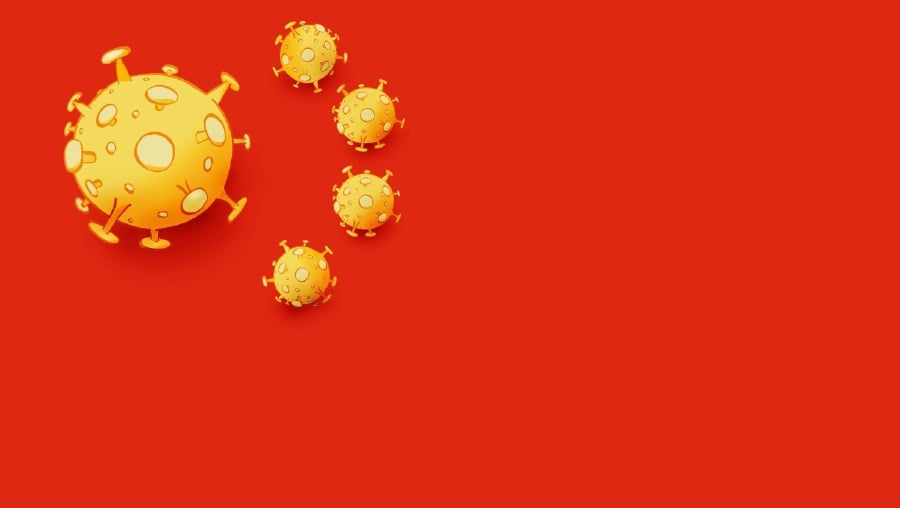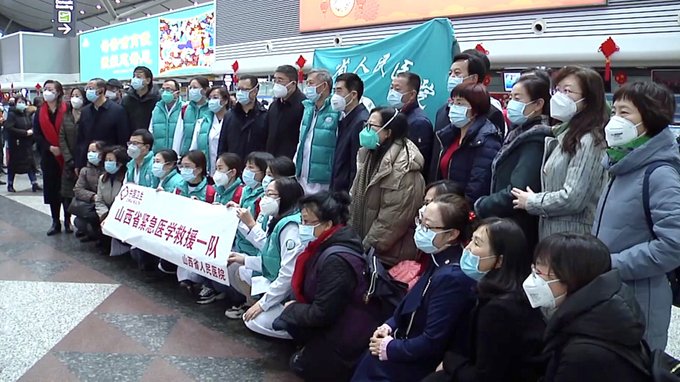Welcome to the Belt and Road Pandemic
There’s one difference between the Wuhan virus and previous Chinese outbreaks: China is now impossible to quarantine.
BY LAURIE GARRETT
 China's most lethal virus: Indian students wear masks of Chinese dictator Xi Jinping in Chennai on Oct. 10, 2019.
China's most lethal virus: Indian students wear masks of Chinese dictator Xi Jinping in Chennai on Oct. 10, 2019.
In an unfortunate turn of translation, China’s Xinhua News Agency
described Xi Jinping’s trip on Jan. 19 to Yunnan province with these words: “The amiable image of the people’s leader moved through the crowd and through the screen,
infecting everyone.”
It was a poor choice of words in a nation in the grips of an infectious respiratory disease epidemic.
But, in another way, the phrasing was entirely apt.
China’s dictator isn’t literally responsible for infecting anyone, but his political agenda turns out to be a root cause of the epidemic.
By making the Belt and Road Initiative endeavor—a multitrillion-dollar program to expand Chinese trade and infrastructure around the world—the centerpiece of his foreign and economic policy, Xi has made it possible for a local disease to become a global menace.
The new virus, according to World Health Organization (WHO) scientists, has a
reproductive rate of as high as 2.5, meaning
each infected individual on average infects as many as 2.5 more people.
That might not seem so bad when an epidemic of four people expands after a few days to 14 more cases, but when 500 cases swells to 1,750, things get serious.
On
Jan. 3, China officially reported 44 cases of Wuhan pneumonia; two weeks later the toll
jumped to 198 cases; on the morning of Jan. 21 the government said 444 patients in Wuhan’s surrounding province of Hubei were confirmed as infected by the virus.
By Jan. 23, the situation was unfolding so rapidly that WHO said at midday in the eastern United States that a total of 575 cases were confirmed in mainland China, then the Chinese government issued a new total of 644 an hour later, and by the next day the tally hit
830 cases with 26 deaths.
In hopes of limiting spread of the new virus, Chinese authorities issued a travel ban and lockdown for the city Wuhan, population 11 million, on Jan. 23.
But the virus had already spread far beyond the city, and cases are emerging now in most Chinese provinces.
The Chinese people awoke on the morning of Jan. 24 to learn that the travel restrictions placed on the people of Wuhan had been expanded to eight other cities, for a total of more than 32 million people whose movements are restricted.
This, on the eve of China’s biggest holiday, the Lunar New Year.
As was the case with SARS, the new virus has spread from person to person through chains of at least four generations of transmission,
infected entire families, and, according to WHO’s outbreak expert
Mike Ryan, left 25 percent of those known to be infected with severe illness requiring intensive care hospitalization.
Confirmed cases have turned up in Thailand, Singapore, Japan, South Korea, Vietnam, Taiwan, Hong Kong, Macao, and the United States.
At the time of this writing, additional pneumonia cases are awaiting laboratory confirmation (or denial) in Mexico, Russia,
Northern Ireland, Scotland, and Rwanda.
Despite the similarities between SARS and the Wuhan pneumonia, and the new virus’s spread across much of China and to some 14 nations, the World Health Organization declined this week to name the Wuhan pneumonia a
Public Health Emergency of International Concern (PHEIC).
“I am not declaring a PHEIC today,” WHO Director-General
Tedros Adhanom Ghebreyesus said in a press conference on Jan. 23, after a contentious expert advisory panel debated the matter for two days, ending up, “divided over whether the outbreak of novel coronavirus represents a PHEIC.”
But Tedros hastily added, “Make no mistake. This is an emergency in China, but it has not yet become a global health emergency. WHO’s risk assessment is that the outbreak is a very high risk in China, and a high risk regionally and globally.”
Ryan, the WHO outbreak expert, repeatedly said in the same press conference that the Wuhan epidemic has met all the criteria for a PHEIC declaration.
It actually exceeds the issues of transmission and spread across national borders that led to last year’s designation of PHEIC status to the Ebola outbreak in the Democratic Republic of the Congo.
But, said Tedros, China is a sovereign nation that has shown “cooperation and transparency” in its handling of the epidemic and “has taken measures it believes appropriate to contain the spread of coronavirus in Wuhan and other cities. We hope that they will be both effective and short in their duration.”
China is also, however, a nation deeply connected to the rest of the world—far more so than was the case when SARS erupted in 2003.
Since 2013, the center of China’s foreign and trade policies is the
Belt and Road Initiative, a massive loan project that includes land and maritime infrastructure, extending to northern Germany, across southern Russia and the Central Asian nations, and down the eastern coast of Africa.
In what is surely the largest infrastructure and investment project in history, covering
70 core countries, the Belt and Road will eventually reach two-thirds of the world population.
According to the
Economic Times, China is spending hundreds of billions of dollars annually throughout this decade on the Belt and Road Initiative; according to some estimates, the program could spend $8 trillion by 2030.
Several major international highways and maritime ports are already completed, and China’s railway system is expanding, both inside the country and outward, across borders.
In 2003, air travel was the only reasonable way to get from, for example, Wuhan to coastal Myanmar, but today a mix of high-speed trains and a superhighway makes the links.
Danger to Africa
Most crucial, in terms of the potential spread of the new virus, is China’s expanded interests and infrastructure in sub-Saharan Africa, especially Eritrea, Ethiopia, Djibouti, Kenya, Zambia, Tanzania, Zimbabwe, and Angola.
The health care systems and capacities in these nations are grossly underprepared to tackle a SARS-like pandemic, and large percentages of the populations are especially vulnerable to severe reactions to infection due to malnutrition and chronic infection with other microbes such as tuberculosis, malaria, HIV, and various parasitic diseases. Wuhan’s Virus and Quarantine Will Hit the Poor Hardest.
Wuhan’s Virus and Quarantine Will Hit the Poor Hardest.
Known as the “thoroughfare of China,” Wuhan is a
key transport and trade hub.
Nationally, growth in China
slowed in 2019 to its most sluggish level in years, but Wuhan expanded 7.8 percent.
On any given business day, nearly a million people ride trains in and out of the city.
The metropolis hosts factories and operations for more than half of the Fortune 500 corporations, with production for the likes of Microsoft and a host of top automakers.
Last year,
27 million passengers flew through Wuhan’s international airport, many of them business travelers.
The Economist Intelligence Unit this week predicted a prolonged epidemic in Wuhan and nearby cities could shave up to 1 percent of China’s 2020 GDP.
Commodities
investors fear that further restrictions on Chinese travel, both domestically and internationally, could so radically reduce oil consumption that crude oil prices might fall by $3 a barrel.
If the Belt and Road Initiative and other Chinese connections with the rest of the world are in 2020 sufficiently robust that a prolonged Wuhan pneumonia epidemic might drive down the nation’s gross domestic product, cheapen world oil prices, and devastate the Shanghai stock market, that vast infrastructure is certainly adequate to provide a serious spread of the virus.
The live animal market from which the epidemic sprung is within walking distance of the Wuhan high-speed railway station, making it convenient for animal dealers to come and go between the city and wildlife hunting grounds in Southeast Asia, Himalayan nations, and Central Asia.
Before the government clamped down on movement out of the city, some
300,000 people fled Wuhan, hoping to reach relatives for the Lunar New Year or simply dodge a crackdown.
Wuhan’s political leaders have
charged the city’s 11 million residents to “enter wartime status and implement wartime measures” to stop the new virus.
But it’s impossible to fathom a scenario in which the new coronavirus does not become a global crisis.
The WHO expert panel was split 50-50 in its decision on whether or not to declare a public health emergency of international concern this week, according to sources present in the deliberations.
Guan Yi of the University of Hong Kong, a veteran virologist who worked on the SARS epidemic,
told the Chinese news agency Caixin, “I’ve seen it all: bird flu, SARS, influenza A, swine fever, and the rest. But the Wuhan pneumonia makes me feel extremely powerless. Most of the past epidemics were controllable, but this time, I’m petrified.”
I, too, am anxious.
It’s hard to look at the new routes built with Chinese aid over Siberia and the Himalayas and as far as Africa without seeing potential routes for disease that could carry contagion to every corner of the world.






 Chinese tourists in Tokyo in October. About a third of all foreign visitors to Japan each year come from China.
Chinese tourists in Tokyo in October. About a third of all foreign visitors to Japan each year come from China.










